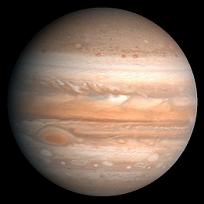Energy Balance of Jupiter

The apparent magnitude of Jupiter varies to some extent because of its varying distance from the Earth, but this is not sufficient to explain all the observed changes. Since 1862, the mean opposition magnitude has ranged over 0.45 magnitudes so that, at the brightest opposition, Jupiter was reflecting 50 percent more light than at the faintest. This means that, as the patterns of the clouds of Jupiter vary, the “ALBEDO”, which is the fraction of the incident sunlight which they reflect, also varies. The Albedo also depends on the wavelength of the light or other radiation being measured, but in the visual range it is typically between 30and 50 per cent.
The solar energy that is not reflected by Jupiter’s clouds is absorbed by the atmosphere. If just this amount of absorbed energy were re-emitted then Jupiter would have an effective temperature of 105K, i.e. it would radiate the same amount of energy as a black body of this temperature and of the same size. Most of the energy is radiated at infrared wavelengths. Measurements show that the effective temperature is actually 125K, so that Jupiter is radiating twice as much energy as it absorbs from the Sun. There is therefore an internal energy source of equal power to the absorption of solar energy. This energy source has important effects on theories both of the internal structure of Jupiter and on the stricture of its atmosphere. Spacecraft measurements show that the day and night sides of Jupiter have the same temperature. This implies that the absorbed solar energy is carried to the night side of Jupiter by the planet’s rotation much more quickly than energy is lost from the atmosphere, in agreement with theoretical calculations.
The belts, zones and other features of Jupiter’s atmosphere show that its structure varies from point to point and from time to time. We can however first consider the average structure of the atmosphere and ignore the local variations (weather) and the details of the dynamical processes. Calculations of a standard model atmosphere can then be made.
About 45% of the incident energy is reflected and more than 10% is absorbed fairly high in the atmosphere so that slightly more than 40% must be absorbed by the clouds in the main body of the atmosphere, which is known as the Troposphere. A similar amount of energy comes from the internal source and enters the troposphere at its base. In the upper troposphere the energy is transported by radiation, whereas in the deep atmosphere the main transport mechanism is convection.